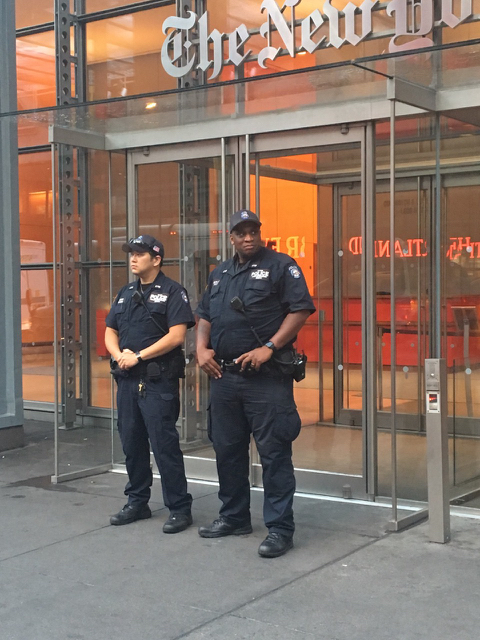Journalists confront their own safety in the aftermath of the Capital Gazette newsroom shooting

Many journalists already felt unsafe by the time a man walked into a Maryland newsroom and opened fire, killing five people.
They had watched shootings unfold in movie theaters, churches, schools. Now, some said, they no longer feel safe in their own newsrooms.
When the news broke, many feared not just for their friends, family members and colleagues — but for the future and safety of journalism as well.
“There is a way that we feel safe in newsrooms,” said Carolyn Ryan, an assistant managing editor at The New York Times. “This was a reminder that we really aren’t always safe and that we can be victims too.”
While The New York Times did not heighten their own security after the shooting, the New York Police Department made the unusual decision to send officers to guard their building and the newsrooms of many other outlets in the city.
The Times also announced that an editor on its masthead would be responsible for reports of employee harassment, physical attacks or threats. Journalists who feel unsafe can report the incident and the editor will alert security, Ryan said.
“Part of what happens when something like this happens to you (is) you feel vulnerable and you feel isolated,” Ryan said. “What we need to do as a newsroom is make sure that the resources that The New York Times, and make sure law enforcement if necessary, is aware of these kinds of threats.”
Other newsrooms have started conducting active shooter drills.
“Fox in New York has been conducting active shooter drills, and I think that’s something a lot of newsrooms will have to kind of confront,” Fox News multimedia reporter Andrew Craft said. “Kind of like an employee-wide effort. You know, see something, say something.”
On June 28, Jarrod Ramos, 38, walked into the Capital Gazette newsroom in Annapolis, Md., and opened fire with a shotgun, prosecutors have said. Five staff members were killed.
Ramos, who is now on trial for 23 criminal charges, including murder, attempted murder, assault and weapons violations, has been described as a disgruntled reader with a history of harassing the journalists in that newsroom.
Journalists are, by and large, used to receiving absurd letters from sources and readers. Some are nastier than others.
Erin Ailworth, a reporter at the Wall Street Journal who usually picks up the office’s daily mail, was caught off guard by one particular note.
“It’s one of the energy team’s stories and it’s written across with epithets in red marker,” Ailworth said. “I was like, ‘What the heck is this? Oh my God, what did I just touch?’ We sent it immediately to our security team. It’s not the first time we’ve gotten one of these letters.”
But threats to journalists’ safety precedes the Capital Gazette shooting, said Vice President of News Services for CBS News Tim Gaughan.
“I think of the Charlie Hebdo shooting in France, where those journalists were targeted” in 2015, Gaughan said. “I think that is when journalists became very conscious that they were potential targets.”
Ailworth has a friend who used to worked at the Gazette and knew the journalists in that newsroom.
“When I saw the news, my mind immediately went to her,” Ailworth said. “You know that it’s going to affect someone that you know. Journalism is not that big of a world when you really start to think about it. We all know someone. We’re all only separated by a couple of degrees.”
Ailworth said her newsroom had a security officer show them what to do in emergency situations years before the Capital Gazette attack.
“We work in an office where anyone can come up the elevator to our floor and our door is glass and there is only one way in and one way out. What do we do?” Ailworth said. “There wasn’t much they could do, but we sort of workshopped: ‘OK, if something were to happen, here’s the plan.’ Will it save us? I hope so, but at least we have a plan.”
For some, like Gaughan, even after covering mass shootings across the country, he was oblivious to the possibility that his own workplace could be a target.
“We’re maybe a little too robotic about our day to day,” Gaughan said. “I know in my experience I could go a week of covering the Las Vegas shooting and the procedure is automatic, but then you come to the end of the week and you unplug a little bit and take yourself out and all of a sudden it hits you what you’ve been covering.”
Some journalists said President Trump’s comments calling media organizations “fake news” or “the real enemy of the people” has added to their anxiety.
The FAKE NEWS media (failing @nytimes, @NBCNews, @ABC, @CBS, @CNN) is not my enemy, it is the enemy of the American People!
— Donald J. Trump (@realDonaldTrump) February 17, 2017
“I really worry about politicians who villainize the press and who stir up anger and hostility toward individual reporters,” Ryan said. “I started noticing this when I oversaw the presidential campaign in 2016, and my reporters who would go to his rallies were verbally assaulted, yelled at, sometimes shoved, and it feels very menacing.”
Email: latinoreporterofficial@gmail.com
Twitter: @bella_paoletto1
Thanks for Sharing